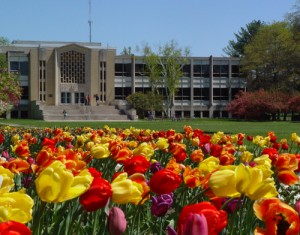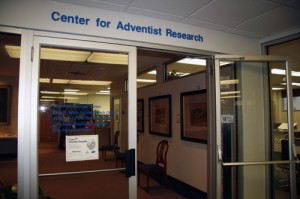The Center for Adventist Research (CAR), seeks to promote an understanding and appreciation of the heritage and mission of the Seventh-day Adventist Church. It is an archive which combines the resources of the Adventist Heritage Center and the Ellen G. White Estate Branch Office to provide to patrons the most extensive collection of Adventist related resources in the world. Located on the lower level of the James White Library at Andrews University, it is positioned to not only facilitate the education of future Seventh-day Adventist church leaders, but to also develop academic and professional links with other Adventist heritage rooms and research centers throughout the world. Beyond the mentioned resources, the Center hosts the Seventh-day Adventist Periodical Index for the Association of Seventh-day Adventist Librarians (ASDAL), houses the Andrews University Archives and Record Center, serves as rare materials repository for the James White Library, houses the Adventist Digital Library (ADL), and actively cooperates in the educational program of the Seventh-day Adventist Theological Seminary and the collection activities of the Seminary library. Patrons of the Center do their own research and are pointed to resources that can be used in such research.
CAR features exhibit space, a Reading Room, lobby, reception area, offices, and multiple storage areas including a large fire-proof, temperature controlled, and gas fire-protected vault. The exhibit space features significant memorabilia and rotating exhibits on the Bible, Adventist history and beliefs, Ellen G. White, and pictures and artifacts relating to Adventist history. In the Reading Room researchers may use comfortable and convenient study areas, a complete set of the published writings of Ellen G. White, reference works on Seventh-day Adventists and Ellen G. White, and a microform reader/printer. There are also computers researchers may use, along with several pieces of audio-visual equipment.
History of the Center
During the 1960s, the White Estate Branch Office and the Adventist Heritage Center developed under the respective leadership of Hedwig Jemison and Louise Dederen. Through the years, these entities aided Andrews University and the Seventh-day Adventist Church in keeping the vision alive of God’s leading in the advent movement. The following is a brief outline of the respective histories and the current arrangements.
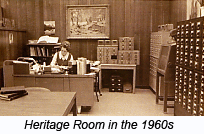
ADVENTIST HERITAGE CENTER. The collecting of historical resources began at the college library of Emmanuel Missionary College (forerunner of Andrews University) during the early part of the twentieth century. Through the years diligent librarians added many resources and carefully preserved them, thus building the collection. In 1959-1960, the Seventh-day Adventist Theological Seminary Library moved to Berrien Springs from Washington, D.C., bringing with it a strong collection of Seventh-day Adventist related materials, including the Advent Source Collection, which were added to the Heritage Room collection greatly augmenting it. In 1966 Louise Dederen became the first full-time Curator of the James White Library Heritage Room, and probably the first full time Adventist heritage librarian. She played a key pioneering role in the development and organization of the Adventist Heritage Center. Between 1966 and 1991, when Mrs. Dederen retired, the Center grew from 1,000 (92m2) to over 5,000 square feet (464m2) in size, and became one of the leading repositories for Adventist resources in the world. From 1991 onward, under the curatorship of Jim Ford, the Center continued to add resources and organize the collections.
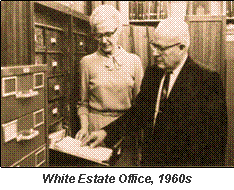
WHITE ESTATE BRANCH OFFICE. Established in 1961, the White Estate office at Andrews University was the first branch office of the Ellen G. White Estate. The establishment of the branch office was originally purely for the purpose of preserving Ellen White related materials in the event of a nuclear disaster in Washington, D.C. But by 1965, due to demand for access to the Ellen White writings, there was a functioning office and organized collection to support the training program of the Seventh-day Adventist Theological Seminary located at Andrews University. A complete set of Ellen G. White letters and manuscripts, rich in original copies, and many other important materials were transferred to the Andrews office and became the core of the collection. Hedwig (Hedy) Jemison was connected with the center from its inception till her retirement in 1984. She served first as secretary and later as an associate director of the White Estate. She was followed by William Fagal who directed the branch office until August of 2003. In 1982 the White Estate Branch Office was relocated from the Seminary building where it had resided since 1961 to a much larger location on the lower level of the James White Library, near the Adventist Heritage Center. The holdings grew to include additional primary and secondary sources related to Ellen G. White. Of particular importance was the greatly expanded document file which contains extensive resources.
TODAY. In 2000 the White Estate Branch office and the Adventist Heritage Center were physically integrated in the south end of the first floor of the James White library. This allowed for a more efficient use of space and centralized access to Adventist related materials. In November 2003, the Center for Adventist Research was officially organized through an administrative integration of the two entities under the leadership of Merlin Burt and Jim Ford, as director and associate director respectively. With an integrated mission the new Center is positioned to be of greater service to the Church than were the individual entities.
Adventist Heritage Resources
The largest part of the Center’s collections are published and unpublished resources by or about the Seventh-day Adventist Church. Among these resources are the following subgroups, most of which may be located via the James White Library catalog.
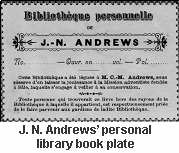 Books, Pamphlets, and Microforms
Books, Pamphlets, and Microforms
The Center holds nearly 60,000 books, over 2,000 Andrews University dissertations and theses, close to 30,000 other text materials, and 12,600 microforms. These items are collected in as many editions and physical appearances, and languages as possible. English is the principal language of the collection, but non-English publications and materials are also extensively collected.
Official Church Publications and Records
Researchers will find in these resources a wealth of information. These include publications from the local church to the General Conference of Seventh-day Adventists, church bulletins, church record books, the histories of local churches, conference directories, year books from many educational institutions, General Conference Bulletins, the Church Manual, Seventh-day Adventist Yearbook, and the Working Policy of the General Conference, North American Division, and many other world divisions.
Seventh-day Adventist Periodicals
Periodical resources include nearly 25,000 volumes of English and non-English Adventist titles comprising over 3,200 different titles. Of these titles, over 900 are non-English titles. This is the finest and most complete collection of its kind in existence, and arguably one of the Center’s most significant resources for historical research. Access is via the James White Library catalog. Do a non-LC call number search for “Car Periodical”.
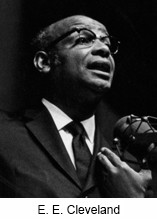
Personal Papers Collections
The Center holds over 325 named personal papers collections comprising over 1,700 linear feet (516 m). These collections of private papers include letters, research material, lecture notes, sermons, writings, diaries, personal memorabilia, photographs, family material, and a host of other type of documents, ephemera, and artifacts. Collections include those from Roy Allan Anderson, M. L. Andreasen, E. E. Andross, E. E. Cleveland, Melvin K. Eckenroth, Frederick Griggs, Edward Heppenstall, John H. Kellogg, J. LaMar McElhany, William Miller, Ron Numbers, Blythe Owen, William W. Prescott, George McCready Price, Leona G. Running, Arthur W. Spalding, William A. Spicer, Edwin R. Thiele, Emmitt K. Vande Vere, Howard B. Weeks, and diaries of John Loughborough, John Byington and the Amadon family. Institutional collections include archives from the Faith for Today, General Conference Archives (presidential letterbooks), It Is Written, the Voice of Prophecy, the Association of Seventh-day Adventist Librarians, and Adventist Historic Ministries. For more details, visit the manuscript section of the Center’s website.
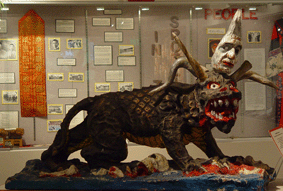
Artifacts and Memorabilia
The Center has a large number of artifacts which originate from every continent and include furniture, musical instruments, implements, primitive weapons, coins, clothing, hand made items, and items of spiritual significance. Some of these items may be viewed as displays in the exhibit space. These include the original trunk which belonged to John N. Andrews, first official Adventist overseas missionary, and stunning early twentieth century three dimensional symbolic beasts described in the Bible books of Daniel and Revelation.
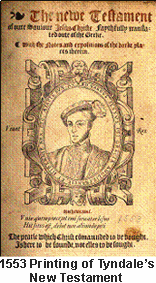
Sound Recordings, Videos and Motion Pictures/Audio and Visual Recordings
The Center holds over 25,000 audio-visual recordings (cassette and reel tapes, video tapes, CD and DVDs, phonograph records, motion pictures, and film strips) on a wide range of topics of special events, conferences, seminars, sermons, special programs, and other church produced or church-related recordings. This includes meetings and programs like General Conference sessions, youth congresses, mission training conferences, marriage and family conferences, ministerial seminars, and ministerial continuing education courses. Also included are recordings of individuals dating back to the first half of the twentieth century. Most of these may be accessed via the James White Library catalog.
Photographic Materials and Images
The Center holds about 36,000 graphic items, such as photographic prints of people, places, and events associated with the Seventh-day Adventist church and Andrews University. Many of these may be accessed via our Photograph Collection database on our website.
Rare Materials and other Special Collections
The Center serves as the rare materials repository for the Andrews University James White Library. It houses a wide range of rare materials which include an extensive collection of Bibles and rare books all of which require greater care than is possible in the general collection of the Library. Included are the Suhrie Bible collection, including a William Tyndale New Testament (1553), several original Torah scrolls, reproductions of the Gutenberg Bible and the Codex Vaticanius, and a copy of Bishop James Ussher’s Chronology, to name but a few of the titles. Two other sets of rare materials are the Martin Luther/Reformation tract collection and the partial library of the denomination’s first official missionary, John N. Andrews.
White Estate Resources
As a Branch Office of the White Estate, the Center contains extensive resources for Ellen G. White studies. These include the following.
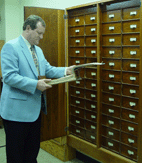
Ellen G. White Unpublished Letters and Manuscripts
Researchers have access to all of the unpublished letters and manuscripts of Ellen G. White similar to what is in the file in the main office at Silver Spring, Maryland. The collections consists of a large number of original copies (many with Ellen White’s handwritten interlineations and signature) as well as photocopies of over 50,000 typewritten pages covering the period from 1845 to 1915. A card index, organized by subject, directs researchers to pertinent material. An online database allows access via a complete numerical listing of all known letters and manuscripts, names of those addressed, file numbers, dates, places of writings, and where the documents, or portions of them, have appeared in print. Work is in process to make the letters and manuscripts available in electronic form.
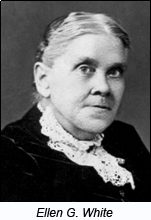 Ellen G. White Office Correspondence
Ellen G. White Office Correspondence
The Center has on microfilm a complete set of the letters received by Ellen White and her office over a span of many years. It is arranged by date and then by writer. An electronic index is available.
White Estate Document File
This collection consists of more than 2,500 topically arranged folders on Ellen G. White, her life and work, and Adventist history. Researchers will find articles, correspondence, manuscripts, ephemera, term papers, and various other documents. These materials can be located via the James White Library catalog.
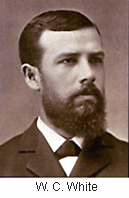
White Family Correspondence
PDFs are available containing correspondence of James White, Ellen’s husband, and J. Edson White, her oldest son. Of special significance is the voluminous correspondence of William C. White, her son, who handled many of her personal and office matters as well as being a very active high church official through much of his life. He was the executor of his mother’s estate and the first director of the White Estate following his mother’s death in 1915 until 1937. W. C. White’s letters can be accessed online.
Ellen G. White Related Research Aids
Various other research aids include indexes, files, and electronic text relating to Ellen White. Examples include the Ellen G. White Biographical Index which has over 2,000 references to events in her life from published and unpublished sources; the Question and Answer File with answers to many questions asked over the years; and the Complete Published Ellen G. White Writings in electronic form. All research aids can be found in the “Find It” menu above.

